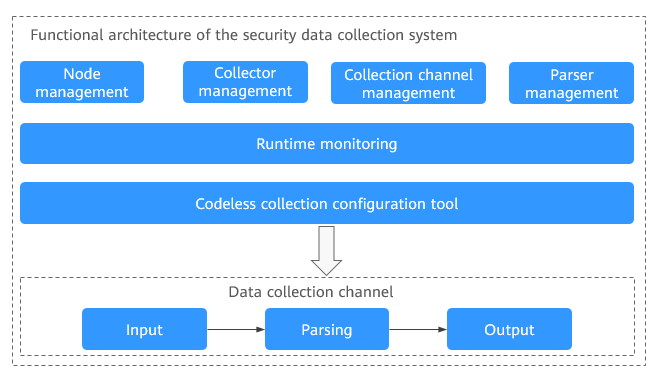Data Collection Overview

Data Collection Principles
The basic principle of data collection is as follows: SecMaster uses a component controller (isap-agent) that is installed on your ECSs to manage the collection component Logstash, and Logstash transfer security data in your organization or between you and SecMaster.

Description
- Collector: custom Logstash. A collector node is a custom combination of Logstash+ component controller (isap-agent).
- Node: If you install SecMaster component controller isap-agent on an ECS, the ECS is called a node. You need to deliver data collection engine Logstash to managed nodes on the Components page.
- Component: A component is a custom Logstash that works as a data aggregation engine to receive and send security log data.
- Connector: A connector is a basic element for Logstash. It defines the way Logstash receives source data and the standards it follows during the process. Each connector has a source end and a destination end. Source ends and destination ends are used for data inputs and outputs, respectively. The SecMaster pipeline is used for log data transmission between SecMaster and your devices.
- Parser: A parser is a basic element for configuring custom Logstash. Parsers mainly work as filters in Logstash. SecMaster preconfigures varied types of filters and provides them as parsers. In just a few clicks on the SecMaster console, you can use parsers to generate native scripts to set complex filters for Logstash. In doing this, you can convert raw logs into the format you need.
- Collection channel: A collection channel is equivalent to a Logstash pipeline. Multiple pipelines can be configured in Logstash. Each pipeline consists of the input, filter, and output parts. Pipelines work independently and do not affect each other. You can deploy a pipeline for multiple nodes. A pipeline is considered one collection channel no matter how many nodes it is configured for.
Limitations and Constraints
- Currently, the data collection component controller can run on Linux ECSs running the x86_64 architecture.
Collector Specifications
The following table describes the specifications of the ECSs that are selected as nodes in collection management.
|
vCPUs |
Memory |
System Disk |
Data Disk |
Referenced Processing Capability |
|---|---|---|---|---|
|
4 vCPUs |
8 GB |
50 GB |
100 GB |
2,000 EPS @ 1 KB 4,000 EPS @ 500 B |
|
8 vCPUs |
16 GB |
50 GB |
100 GB |
5,000 EPS @ 1 KB 10,000 EPS @ 500 B |
|
16 vCPUs |
32 GB |
50 GB |
100 GB |
10,000 EPS @ 1 KB 20,000 EPS @ 500 B |
|
32 vCPUs |
64 GB |
50 GB |
100 GB |
20,000 EPS @ 1 KB 40,000 EPS @ 500 B |
|
64 vCPUs |
128 GB |
50 GB |
100 GB |
40,000 EPS @ 1 KB 80,000 EPS @ 500 B |
|
NOTE:
|
||||
Log Source Limit
You can add as many as log sources you need to the collectors as long as your cloud resources can accommodate those logs. You can scale cloud resources anytime to meet your needs.
Data Collection Process

|
No. |
Step |
Description |
|---|---|---|
|
1 |
Select or purchase an ECS and install the component controller on the ECS to complete node management. |
|
|
2 |
Install data collection engine Logstash on the Components tab to complete component installation. |
|
|
3 |
Configure the source and destination connectors. Select a connector as required and set parameters. |
|
|
4 |
Configure codeless parsers on the console based on your needs. |
|
|
5 |
Configure the connection channels, associate it with a node, and deliver the Logstash pipeline configuration to complete the data collection configuration. |
|
|
6 |
Verifying the Collection Result |
After the collection channel is configured, check whether data is collected. If logs are sent to the SecMaster pipeline, you can query the result on the SecMaster Security Analysis page. |
Data Collection Configuration Removal Process

|
No. |
Step |
Description |
|---|---|---|
|
1 |
Deleting a collection channel |
On the Collection Channels page, stop and delete the Logstash pipeline configuration. Note: All collection channels on related nodes must be stopped and deleted first. |
|
2 |
(Optional) Deleting a parser |
If a parser is configured, delete it on the Parsers tab. |
|
3 |
(Optional) Deleting a data connection |
If a data connection is added, delete the source and destination connectors on the Connections tab. |
|
4 |
Removing a component |
Delete the collection engine Logstash installed on the node and remove the component. |
|
5 |
Deregistering a node |
Remove the component controller to complete node deregistration. Note: Deregistering a node does not delete the ECS and endpoint resources. If the data collection function is no longer used, you need to manually release the resources. |
Feedback
Was this page helpful?
Provide feedbackThank you very much for your feedback. We will continue working to improve the documentation.See the reply and handling status in My Cloud VOC.
For any further questions, feel free to contact us through the chatbot.
Chatbot





